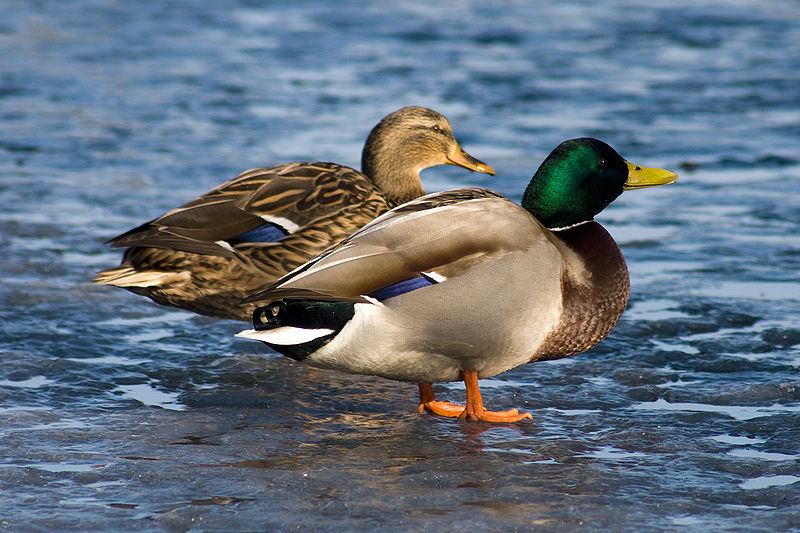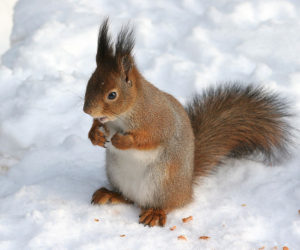Countercurrent Exchange in Nature

or "Why Ducks Don't Wear Mucklucks"
Have you ever looked at a duck swimming in icy water and wondered how they do that without wearing dive booties? Or have you ever looked at a squirrel sitting in snow calmly eating seeds and wondered why it's not racing for the nearest heated mani-pedi spa? All animals have unique adaptations for dealing with cold, ranging from boosted fat stores to growing extra feathers and double coated fur, but some animals have developed something called "countercurrent exchange." It's a trait that animals who are active in extreme conditions have converged upon as a way to deal with hot and cold temperatures, especially in snow, ice, cold water, and even tropical rain forests.
An animal's trunk is the hub of its body, and there are lots of ways it has to keep warm and cool; however, they have a unique problem. Their feet are far away from the main trunk of their body, blood has to travel a ways to get there, and their limbs are often not as furry or as thick as the main body. What's an animal to do to keep those limbs warm in the winter and cool in the summer without toes inconveniently dropping off? It would be easier if they could just Mr-Potato head their limbs on and off but they can't. The answer is to warm and cool those extremities efficiently while maintaining the minimum or maximum temperature for tissues to survive. To do this many animals use countercurrent exchange.

WHAT IS COUNTERCURRENT EXCHANGE?
Countercurrent exchange is a way that fluids in the body can change their properties (remember that a fluid can be liquid or gas). Countercurrent exchange:
- Can be used to transfer heat, fluids, nutrients, or oxygen
- Occurs across semi-permeable membranes (the walls let stuff through) of veins and arteries
- The fluids flowing through the veins and arteries has to be in close proximity and going in opposite directions (think of parallel race tracks or two spans of a bridge with traffic going in different directions) for countercurrent exchange to happen
- There is a gradient of "stuff" going in different directions (warm blood v. cold blood, warm air v. cold air, low oxygen blood v. high oxygen blood, etc.) in the exchange
HOW DOES COUNTERCURRENT EXCHANGE DO THE "EXCHANGING"?
The best way to understand countercurrent exchange is by looking at a common example, duck feet. Warm blood is coursing from the duck's body straight toward their cold webby feet. If the blood flowed right out into the feet then what would happen? The warm blood would cool quickly and the duck would be using a lot of energy to keep its feet as warm as its body. Also, if the cold blood in the feet was going in a straight line to the heart to be warmed and re-oxygenated then the duck would be continuously cold (and need wee sweaters and boots). This would be incredibly inefficient and could result in hypothermia. Instead, there is a complex network of veins and spread out along the leg where warm blood going to the foot meets cold blood coming from the foot (remember that bridge analogy?).

WHAT ANIMALS USE COUNTERCURRENT EXCHANGE?
Most of the time I think of countercurrent exchange in the winter, when I'm freezing my own tail feathers off, but it's not just ducks and water birds that have it. Here are some examples:
- Fish gills-exchange oxygen from the high oxygen environment of the water around them into the low oxygen environment of their bloodstream.
- Arctic foxes and wolves- use countercurrent exchange to heat and cool their feet so that they don't freeze in the ices and snow
- Jackrabbits- use this exchange in their ears to help cool their bodies

- Kangaroo rats- face dehydration in the desert, and don't want to lose moisture by exhaling moist air from their lungs so they use countercurrent exchange to inhale dry air that is cooled and moistened on way to lungs and old air is warmed and water taken out of it on the way out the nose
- Beavers. muskrats, and otters- use countercurrent exchange to their extremities while swimming in water
- Marine mammals- whales, seals, and sea lions use countercurrent exchange to heat and cool their extremities in and out of water (depending on the creature)
- Manatees- uses countercurrent heating and cooling in its tail to maintain body temperature in its thick and slow moving body
- Sloths- use countercurrent exchange their arm and legs to regulate their body temperature
There are lots more examples in the animal kingdom, these are just the tip of the iceberg, ranging from human kidneys to gazelle brains. Countercurrent exchange is an effective way to heat and cool fluids in and out of the body. Humans can do it to some extent, but not as well as their vertebrate counterparts around the globe.

Next time you see a duck in an icy lake, don't reach for tiny ducky-mucklucks; and if you see a squirrel sitting with its feet in the snow, don't worry about a squirrel foot warmer, they're all fine. Consider what an awesome adaptation countercurrent exchange is, and how amazing nature can truly be when you look up close.

